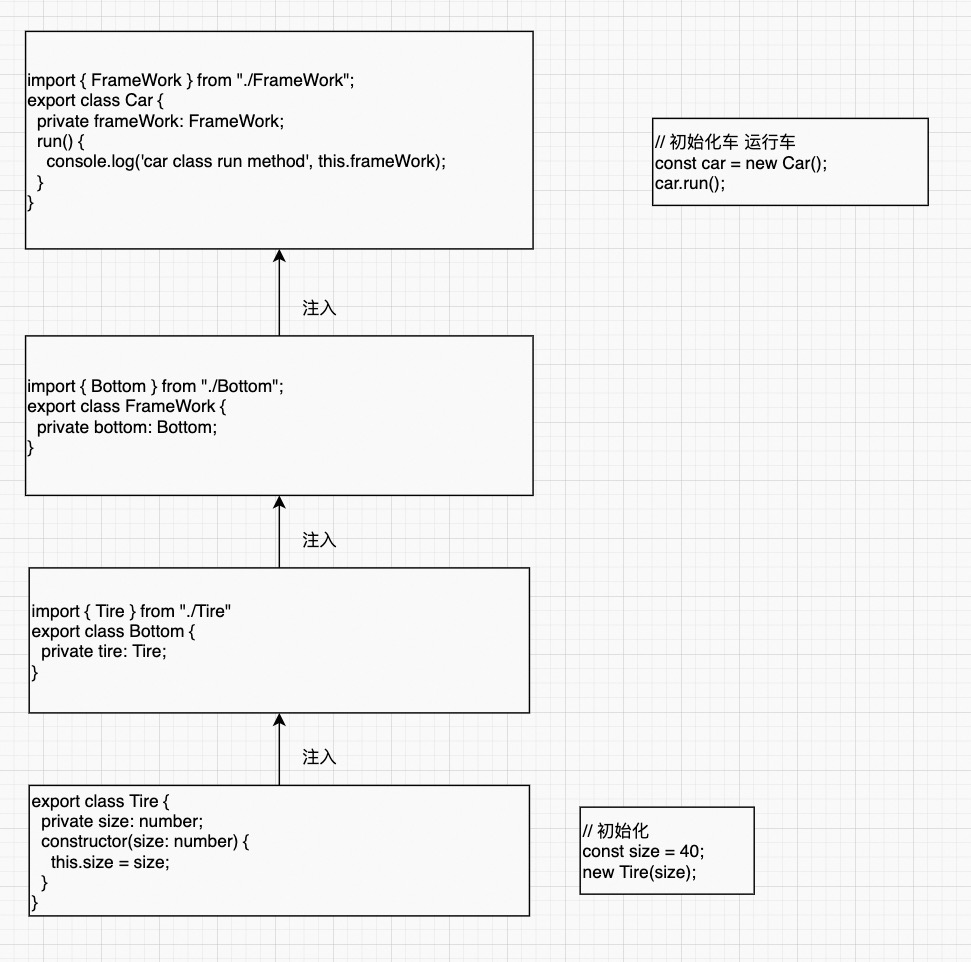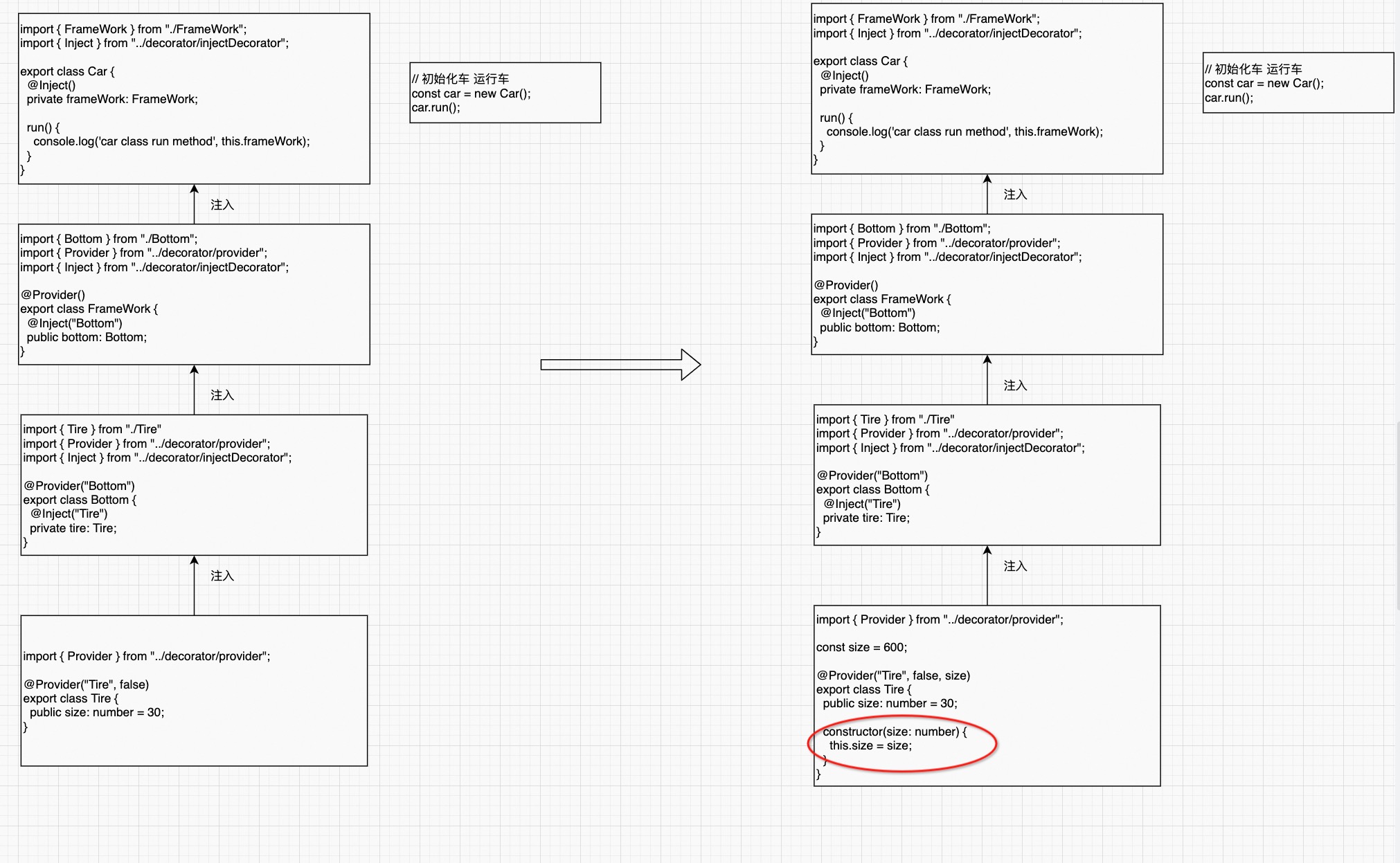TypeScript 装饰器之依赖注入
墙裂建议 先看上一篇文章:TypeScript 装饰器完全指南
什么是依赖注入 依赖注入是将一个对象所依赖的其他对象直接提供给这个对象,而不是在当前对象中直接实例化这些依赖的对象。
在Dependency Injection Demystified 一文中的解释更是让人啧啧称赞:
Dependency injection means giving an object its instance variables. Really. That’s it.
为什么要依赖注入 考虑下面这种场景:
我们先定义四个Class,车,车身,底盘,轮胎。然后初始化这辆车,最后跑这辆车。
假设我们需要改动一下轮胎(Tire)类,把它的尺寸变成动态的,而不是一直都是30。
由于我们修改了轮胎的定义,为了让整个程序正常运行,我们需要做以下改动:
由此我们可以看到,仅仅是为了修改轮胎的构造函数,这种设计却需要修改整个上层所有类的构造函数!在软件工程中,这样的设计几乎是不可维护的。
所以我们需要进行控制反转(IoC),即上层控制下层,而不是下层控制着上层。我们用依赖注入(Dependency Injection) 这种方式来实现控制反转。所谓依赖注入,就是把底层类作为参数传入上层类 ,实现上层类对下层类的“控制”。
这里我只需要修改轮胎类就行了,不用修改其他任何上层类。这显然是更容易维护的代码。并且依赖注入还有利于:
便于单元测试
解耦,统一管理被依赖对象的实例化,不用在类的内部创建被依赖对象
环境配置 1 2 3 4 5 6 7 8 9 { "compilerOptions" : { "experimentalDecorators" : true , "emitDecoratorMetadata" : true , } }
借鉴 midway 中的依赖注入实现方式,开始完成我们的基于TS装饰器和 Reflect-metadata的依赖注入。
框架设计
我们需要用一个Map来存储注册的依赖,并且它的key必须唯一,所以我们首先设计一个容器Container类。
注册依赖的时候尽可能简单,甚至不需要用户自己定义key,所以这里使用 Symbol 和唯一字符串来确定一个依赖。
Container 先来设计一个Container类,它包括ContainerMap、set、get、has属性或方法。ContainerMap用来存储注册的模块,set和get用来注册和读取模块,has用来判断模块是否已经注册。
set 形参 id 表示模块 id, value 表示模块。get 用于返回指定模块 id 对应的模块。has 用于判断模块是否注册。
1 2 3 4 5 6 7 8 9 10 11 12 13 14 15 16 17 18 19 class Container { private containerMap = new Map <string | symbol , any >(); public set (id : string | symbol , value : any ): void { this .containerMap .set (id, value); } public get<T extends any >(id : string | symbol ): T { return this .containerMap .get (id) as T; } public has (id : string | symbol ): boolean { return this .containerMap .has (id); } }; const containerInstance = new Container ();export default containerInstance;
Provider 类装饰器 现在实现 Provider 类实现注册类:
1 2 3 4 5 6 7 8 9 10 11 12 13 14 15 16 17 18 19 20 21 22 23 24 25 26 27 28 29 30 31 32 33 34 35 36 import 'reflect-metadata' ;import containerInstance from "../container" ;export function Provider ( id?: string , singleton?: boolean , ...args: any [] ClassDecorator { return (target: any ) => { let _id; let _singletonInstance; if (id && containerInstance.get (id)) { throw new Error (`[Service]: 此标识符(${id} )已被注册使用` ); } _id = id || Symbol (target.name ); Reflect .defineMetadata ('cus:id' , _id, target); Reflect .defineMetadata ('cus:args' , args, target); Reflect .defineMetadata ('cus:singleton' , Boolean (singleton), target); if (singleton) { _singletonInstance = new target (...args); } containerInstance.set (_id, _singletonInstance || target); } }
Inject 属性装饰器 Inject 属性装饰器是完成将完成注册的类实例注入到容器类中。
1 2 3 4 5 6 7 8 9 10 11 12 13 14 15 16 17 18 19 20 import 'reflect-metadata' ;import containerInstance from "../container" ;export function Inject (id?: string ): PropertyDecorator { return (target: Object , propertyKey: string | symbol ) => { const dependency = Reflect .getMetadata ('design:type' , target, propertyKey); const _isSingleton : boolean = Reflect .getMetadata ('cus:singleton' , dependency); const _args : any [] = Reflect .getMetadata ('cus:args' , dependency) ?? []; const _id = id || Reflect .getMetadata ('cus:id' , dependency); const _dep : any = containerInstance.get (_id); if (!_dep) throw new Error (`[Error in Inject]: Container 中未注册 ${id} ` ); Reflect .defineProperty (target, propertyKey, { value : _isSingleton ? _dep : new _dep (..._args), }); } }
使用依赖注入 还是以最开始的例子为例,修改底层类是否会对上层类造成影响;
可以看到类与类之间是解耦的,无需修改上层类来适配下层类的修改。
完整的代码如下:
1 2 3 4 5 6 7 8 9 10 11 12 13 14 15 16 17 18 19 20 21 22 23 24 25 26 27 28 29 30 31 32 33 34 35 36 37 38 39 40 41 42 43 44 45 46 47 48 49 50 51 52 53 54 55 56 57 58 59 import { FrameWork } from "./FrameWork" ;import { Inject } from "../decorator/injectDecorator" ;import { Tire } from "./Tire" ;export class Car { @Inject () private frameWork : FrameWork ; @Inject ('Tire' ) private tire : Tire ; run ( console .log ('car class run method' , this .frameWork ); console .log (this .tire .size ); } } import { Bottom } from "./Bottom" ;import { Provider } from "../decorator/provider" ;import { Inject } from "../decorator/injectDecorator" ;@Provider ()export class FrameWork { @Inject ("Bottom" ) private bottom : Bottom ; } import { Tire } from "./Tire" import { Provider } from "../decorator/provider" ;import { Inject } from "../decorator/injectDecorator" ;@Provider ("Bottom" )export class Bottom { @Inject ("Tire" ) private tire : Tire ; } import { Provider } from "../decorator/provider" ;const size = 600 ;@Provider ("Tire" , false , size) export class Tire { public size : number ; public count : number ; constructor (size: number ) { this .size = size; } }
Controller 与 Get 的实现(基于 Decorator) 上面我们基于 TS 装饰器和 Reflect-metadata 实现了一个简单的依赖注入。在 midway 中还有几个非常常用的装饰器,比如:Controller、Get、Post等,下面我们尝试实现下这几个装饰器,并完成Controller的自动扫描。最后我们通过本地的koa服务来验证结果是否符合预期。
记录路由信息 我们需要通过 Controller、Get、Post 装饰器把当前的路由信息通过 Reflect-metadata 记录下来,以方便后续我们将这些路由信息绑定在koa或者express框架上。
借鉴 midway 的经验,Controller 装饰器中应该记录路由的前缀,默认值是’’
下面我们来完成 Controller、Get、Post 装饰器:
1 2 3 4 5 6 7 8 export const METHOD_METADATA = 'method' ;export const PATH_PREFIX_METADATA = 'path_prefix' ;export const PATH_METADATA = 'path' ;export const Controller = (prefix : string = '' ): ClassDecorator =>target => Reflect .defineMetadata (PATH_PREFIX_METADATA , prefix, target); };
1 2 3 4 5 6 7 8 9 10 11 const createResquestMethod = (method: 'GET' | 'POST' ) => (path : string ): MethodDecorator => (target: Object , propertyKey: string | symbol , descriptor: PropertyDescriptor ) => { Reflect .defineMetadata (PATH_METADATA , path, descriptor.value ); Reflect .defineMetadata (METHOD_METADATA , method, descriptor.value ); } export const Get = createResquestMethod ('GET' );export const Post = createResquestMethod ('POST' );
处理路由信息 上一步中我们把路由的信息做了记录,接下来我们需要一个函数,这个函数的输入为某个构造函数,输出为这个构造函数的路由信息(前缀、path、路由动作等)。
1 2 3 4 5 6 7 8 9 10 11 12 13 14 15 16 17 18 19 20 21 22 23 24 25 26 27 28 29 30 31 32 33 34 35 36 37 38 39 40 41 42 43 44 45 46 47 48 49 50 51 52 import 'reflect-metadata' ;import { PATH_PREFIX_METADATA , PATH_METADATA , METHOD_METADATA } from '../decorator/controllerDecorator' ;export type RouteInfo = { path : string ; method : 'GET' | 'POST' , fn : Function , classFn : new () => any , methodName : string , }; export const isConstrucor = (fn : any ): boolean => try { new fn (); } catch (err) { if (err.message .indexOf ('is not a constructor' ) >= 0 ) { return false ; } } return true ; }; export const isFunction = (functionToCheck): boolean => return functionToCheck && Object .prototype toString .call (functionToCheck) === '[object Function]' ; }; export const mapRoute = (classFn : new () => any ): { prefix : string , info : RouteInfo [] } => { const prefix = Reflect .getMetadata (PATH_PREFIX_METADATA , classFn); const methodNames = Object .getOwnPropertyNames (classFn.prototype .filter (item =>isFunction (classFn.prototype isConstrucor (classFn.prototype const info : RouteInfo [] = methodNames.map (methodName => const fn : Function = classFn.prototype const path : string = Reflect .getMetadata (PATH_METADATA , fn); const method : 'GET' | 'POST' = Reflect .getMetadata (METHOD_METADATA , fn); return { path, method, fn, classFn, methodName, }; }); return { prefix, info } }
启动 Koa 服务 到目前为止我们可以通过 mapRoute 方法拿到类上我们自定义的一些 metadata,包含了路由信息。下面我们需要把路由信息给到Koa,来验证我们的路由信息是否正确。
我们现在准备一个Controller和一个Service:
Service:
1 2 3 4 5 6 7 8 9 10 11 12 13 14 15 16 17 import { Provider } from "../decorator/provider" ;@Provider ()export class WebService { getListById ( return [ { name : 'test' , age : 18 , }, { name : 'te2st' , age : 13 , }, ]; } };
Controller:
1 2 3 4 5 6 7 8 9 10 11 12 13 14 15 16 17 18 19 20 21 22 23 24 25 26 27 28 29 30 import { Config } from '../decorator/configDecorator' ;import { Provider } from '../decorator/provider' ;import { Controller , Get , Post } from '../decorator/controllerDecorator' ;import { Inject } from '../decorator/injectDecorator' ;import { WebService } from '../service/webService' ;@Provider ()@Controller ('/web' )export class WebController { @Config ('token' ) token; @Inject () webService : WebService ; @Get ('/list' ) getList ( const data = this .webService .getListById (); return { success : true , msg : 'ok' , data, token : this .token , }; } @Post ('/update' ) updateListInfo ( }
设想下符合预期的场景:当本地服务启动,我们在浏览器访问 localhost:port/web/list 的时候应该可以正常返回接口数据。
Koa 本地服务:
1 2 3 4 5 6 7 8 9 10 11 12 13 14 15 16 17 18 19 20 21 22 23 import Koa from 'koa' ;import Router from 'koa-router' ;import 'reflect-metadata' ;import { mapRoute } from "../utils/common" ;import { WebController } from '../controller/webController' ;const app = new Koa ();const router = new Router ();const { prefix, info } = mapRoute (WebController );info.forEach (item => const { path, method, fn, classFn } = item; router[method.toLowerCase ()](`${prefix} ${path} ` , (ctx, next ) => { ctx.body = fn.bind (classFn.prototype }) }); app.use (router.routes ()); app.listen (3000 , () => { console .log ('service is running...' ); });
自动扫描 其实在上一步我们的目的已基本达成,但是想一个场景:每次你新增 Controller 的时候都要到本地服务这个文件来引入这个 Controller 文件,在调用 mapRoute 方法获取路由信息,很麻烦。因此我们可以在本地服务启动的时候,自动扫描 Controller 文件夹,获取到所有的具备Provider装饰器的Controller类,然后获取类上的路由信息。
1 2 3 4 5 6 7 8 9 10 11 12 13 14 15 16 17 18 19 20 21 22 23 24 25 26 27 28 29 30 31 32 33 34 35 36 37 38 39 40 41 42 43 44 45 46 47 48 49 50 import Koa from 'koa' ;import Router from 'koa-router' ;import 'reflect-metadata' ;import { globSync } from 'glob' ;import { mapRoute, isConstrucor } from "../utils/common" ;const getRouterInfoList = ( const controllerList = globSync ('**/controller/*.ts' , { absolute : true , }); const classFnList : Record <string , { new (): any }>[] = controllerList.map (controller =>require (controller)); const routeInfoList = classFnList.map (classFn => return Reflect .ownKeys (classFn) .filter (key =>'__esModule' ) .map ((className: string ) => { const _class = classFn[className]; const id = Reflect .getMetadata ('cus:id' , _class); const isCons = isConstrucor (_class); if (isCons && id) { return mapRoute (_class); }; }); }).flat ().filter (Boolean ); return routeInfoList; } const routeInfoList = getRouterInfoList ();const app = new Koa ();const router = new Router ();routeInfoList.forEach (({ prefix, info } ) => { info.forEach (item => const { path, method, fn, classFn } = item; router[method.toLowerCase ()](`${prefix} ${path} ` , (ctx, next ) => { ctx.body = fn.bind (classFn.prototype }) }); }); app.use (router.routes ()); app.listen (3000 , () => { console .log ('service is running...' ); });
到此我们就完成了Controller、Get、Post装饰器,并且通过本地服务验证其正确性。
总结
了解了什么是装饰器;
装饰器的应用
依赖注入
midway 中的 Controller、Get、Post装饰器的实现
koa本地服务验证
自动扫描 Controller
最后 JavaScript 构建的应用不总是 OOP 的,依赖注入(控制反转)衍生于 Java 等传统技术生态,在开发习惯上存在差异。高效合理地使用 IOC 需要较大的学习成本和开发经验。但是这篇文章希望可以给大家带来一些思路和启发。
参考文章











